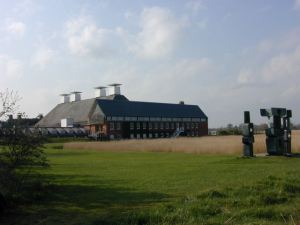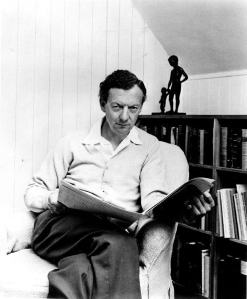Last week Benjamin Britten would have been one hundred years old, and quite rightly there have been a plethora of events internationally involving many of my friends and colleagues in honour of the anniversary. Although I have not been involved personally in the centenary celebrations, I guess I owe the composer of the War Requiem a blog post at the very least, as his works played a decisive role in my decision to become a professional musician. In 1980, four years after his death, I and a dozen teenage schoolfriends in Trinity School Boys’ Choir under its founder David Squibb (1935-2010) spent several months singing in two productions of Benjamin Britten’s A Midsummer Night’s Dream, first at the Royal Academy of Music in London and then in residence at the mythical location of Snape Maltings, home to the Aldeburgh Festival. This was my first experience of opera, and it could scarcely have been a more absorbing, magical introduction to its multiple dimensions. In terms of becoming acquainted with the world of professional music and theatre, I look back on it as a truly formative time whose impact on my thinking as a composer and performer I can still feel today.
The part played by the boys’ chorus in the Aldeburgh production of A Midsummer Night’s Dream was considerable not only in terms of singing but also movement, which in Christopher Renshaw’s staging meant spending many hours rehearsing on a somewhat intimidating triangular metal gantry which I got to know intimately as it slid back and forwards on rails onstage. In my mind’s eye I can still see the metal bar to which I clung ape-like during the opening bars (featuring Britten’s memorable double bass glissandi evoking a donkey’s braying) ready to spring into action for the first chorus ‘Over hill over dale’. If these acrobatics certainly provoked a stirring of my thirteen year-old blood, the most delicate moment however came in the third act, with a dance sequence (for which we were given instruction by a coach from the Ballet Rambert) which we had to perform seated near the top of the gantry, which I would perhaps have experienced as less vertiginous had I been allowed to wear my glasses on stage but which I found worryingly tall.
Various incidents remain in my mind from my time in Suffolk, including a variety of typical adolescent pranks (such as the choir drenching each other and their chorus master mercilessly in a water battle in kayaks on a mini-lake near Lowestoft, or a friend’s failed(!) attempt to wake me by blowing a trumpet full volume in my ear while I was asleep). This was a time when I was probably more concerned at my inability to sight-read the piano introduction to Rudy from Supertramp’s Crime of the Century – an album whose lasting influence on me probably shows up somewhere in my own works if you look hard enough – than to memorize my part in the opera. What stays in my memory above all, however, is the general atmosphere of Aldeburgh, the East Anglian landscape and the backdrop of the North Sea, in which I recall taking one brief freezing dip and which Britten evoked so unforgettably in the Four Sea Interludes to Peter Grimes. During the production we were housed in a large house in Leiston, where I stayed in a room from which I could see the impressively grey mass of water extending unbroken to Friesland, Schleswig-Holstein and Scandinavia. As I looked out in the evenings, scouring the horizon in search of the lights of passing ships, the view did not fail to catch my imagination just as it had once caught Britten’s (and other artists fascinated by this brooding seascape such as the nineteenth-century German writer Theodor Storm, who penned his haunting Schimmelreiter on its Eastern banks in Husum, ‘die graue Stadt am Meer’ – ‘the grey town by the sea’ – an epithet which could equally well describe Aldeburgh). There is a peculiar poetic quality to Northern European skies which is hard to capture in the space of a few words but which has left an indelible stamp on innumerable pieces of music, at least as I hear them, from the storm in Tchaikovsky’s Queen of Spades or the existential loneliness of Sibelius’s tone-poems to the strangely hovering flute arabesques of Shostakovich’s Sixth Symphony or, changing genre slightly, a host of ECM jazz releases by Jan Garbarek, Terje Rypdal, Arild Andersen and others.
Given the Athenian setting of Shakespeare’s play, A Midsummer Night’s Dream is obviously not one of Britten’s quintessentially East Anglian or maritime works, but its writing shares with them a powerfully evocative, often dream-like quality. I can still recall the sense of enchantment that I experienced when walking alone beneath the stage at the opening of Act III just before our entrance in order to listen to the orchestral prelude. Listening to this brief passage for strings again today, I am no less struck by its interiority and economy of line now than I was as a teenager. Britten was undoubtedly one of the twentieth-century’s greatest masters of ‘diatonic dissonance’ in terms of his control of the melodic/harmonic tension that can be generated by simply allowing tonal or modal lines to sound against one another or to float eerily over foreign pedal notes, even in the sparest of textures (think of the hypnotic meditation ‘Look, through the port comes the moonlight astray’ sung by the title character of Billy Budd prior to his execution). It is no secret to anyone familiar with his biography that Britten, who was able to convey a sense of malevolence as few other composers (The Rape of Lucretia, The Turn of the Screw…), was at times a tortured individual, yet there is also a great purity in his diatonic music, a yearning for lost innocence that was among the qualities that inspired Arvo Pärt to write his Cantus in memoriam Benjamin Britten on the latter’s death in 1976:
Why did the date of Benjamin Britten’s death – December 4, 1976 – touch such a chord in me? During this time I was obviously at the point where I could recognise the magnitude of such a loss. Inexplicable feelings of guilt, more than that even, arose in me. I had just discovered Britten for myself. Just before his death I began to appreciate the unusual purity of his music – I had had the impression of the same kind of purity in the ballads of Guillaume de Machaut. And besides, for a long time I had wanted to meet Britten personally – and now it would not come to that.'[1]
I too never met Benjamin Britten, although Sir Peter Pears did sign my programme of A Midsummer Night’s Dream backstage in Aldeburgh in 1980. A year later my voice had broken and I would not sing in the War Requiem alongside my classmates (although I did play the piano part in a performance at Snape Maltings many years later); my time singing Britten’s music as a boy treble was over. Yet my admiration for the composer has remained unchanged ever since, and writing from my continental European vantage-point it now seems clearer than ever that he alone of British musicians of the mid twentieth-century generated a compositional corpus endowed with sufficient universality to speak to international audiences in locations far removed from Britten’s own cultural hinterland.
The War Requiem in particular has lost nothing of its relevance half a century after its first performance; like Shostakovich, Britten here is a chronicler of history who both recalls and warns. Like the perennial liturgical text and Wilfred Owen’s poetry which it sets, Britten’s music continues to speak in a world which is no less battle-scarred than it was at the time of the Requiem‘s première in the ruins of Coventry Cathedral in 1962. A performance of the Offertorium remains a chilling experience; the logic of humanity’s terrible refusal to sacrifice the ‘Ram of Pride’ rather than ‘half the seed of Europe, one by one’ in 1914-1918 is tragically very much still with us. Both for this reason and in its inherent musico-poetic structure, the War Requiem remains in some sense an open-ended work (not unlike Beethoven’s Missa Solemnis), whose unresolved tension eludes easy closure and prevents us from forgetting what in this world’s history has remained unreconciled.
Nowhere is this more apparent than at the end of the baritone solo ‘After the blast of lightning from the East’ following the Sanctus, concluding with Owen’s troubled words:
And when I hearken to the Earth, she saith:
“My fiery heart shrinks, aching. It is death.
Mine ancient scars shall not be glorified,
Nor my titanic tears, the sea, be dried.”
Listening to the War Requiem as I write and thinking of Aldeburgh as I remember it three decades ago, it is that brooding grey expanse of titanic tears which comes before my mind’s eye.
Let us sleep now…
[1] Quoted in Paul Hillier, Arvo Pärt (Oxford/New York: Oxford University Press, 1997), 101.





